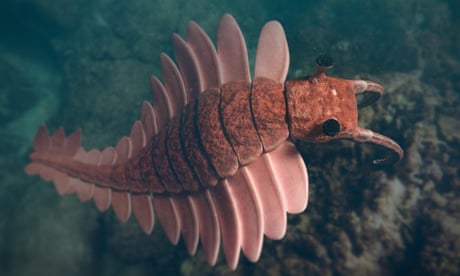At the centre of the Earth, a giant sphere of solid iron is slowly swelling. This is the inner core and scientists have recently uncovered intriguing evidence that suggests its birth half a billion years ago may have played a key role in the evolution of life on Earth. At that time, our planet’s magnetic field was faltering – and that would have had critical consequences, they argue.
Normally this field protects life on the surface by repelling cosmic radiation and charged particles emitted by our sun. But 550m years ago, it had dropped to a fraction of its current strength – before it abruptly regained its power. And in the wake of this planetary reboot, Earth witnessed the sudden proliferation of complex multicellular life on its surface.
This was the Cambrian explosion, when most major animal groups first appeared in the fossil record. Now scientists have linked it to events at the very centre of the Earth. graphic Our planet consists of spheres.
There is a 5-70km-thick layer of rock that covers Earth like an eggshell. This is called the crust and below it lies the mantle, made up of a 3,000km layer of silicates. Further down, there is the outer core, made of molten iron, and inside it there is another sphere – of solid iron.
It is more than 2,000km in diameter and is growing by about a millimetre a year. “Earth’s magnetic field is generated by swirling iron in the outer core,” said John Tarduno, professor of geophysics at the University of Rochester, New York. “Before the Cambrian explosion the core was entirely molten and its ability to generate a magnetic field was collapsing.
” Analysis of crystals in rocks in Quebec by Tarduno’s team has shown that Earth’s magnetic field was less than 10% of its current strength and would have provided poor protection against cosmic and solar radiation. The dynamo that drives Earth’s magnetic field was probably losing power because of rapid heat loss from the core, it is argued. Then the core began to solidify at its centre, which had profound consequences.
Essentially it turbocharged motions in the outer core, restoring the strength to the planet’s magnetic field. “Our research indicates that the formation of the inner core began approximately 550m years ago and that happened just before the Cambrian explosion occurred,” said Tarduno. Why and how the inner core was born had been a mystery.
From its tiny beginning half a billion years ago it has grown to a moon-sized sphere of solid iron. It is the most metallic place on Earth and it has had a major impact on conditions on the surface. A view of snow-covered Stolby nature reserve, in Krasnoyarsk, Russia.
These rock pillars date from the Cambrian period, more than 600m years ago, to the Carboniferous period. Photograph: Anadolu Agency/Getty Images Most importantly, it provided our world with a magnetic field. Observations of other worlds – where these fields have disappeared – reveal the dramatic consequences of this loss.
An example is provided by Mars, which lost its magnetic field 4bn years ago. Without protection from the solar wind – the continual stream of protons and electrons that pour out from the surface of the sun – the Martian atmosphere was driven off into space, leaving its surface dead and waterless. “Earth would not have evolved like Mars but it certainly would have lost more water than it has today if it had not rebooted its magnetic field,” added Tarduno.
“It would certainly have been a very much drier planet that the one we live in today. ” However, the geophysicist was reluctant to speculate exactly how the rebirth of Earth’s magnetic field would have influenced the evolution of life. “I don’t think that the return of Earth’s magnetic field and the subsequent explosion of life on Earth can be unconnected.
But we cannot say what was the exact patten of events as yet. That needs more study. ”.
From: theguardian
URL: https://www.theguardian.com/science/2022/jul/03/explosion-of-life-on-earth-linked-to-heavy-metal-act-at-planets-centre



